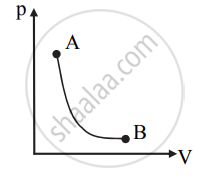Advertisements
Advertisements
Question
Explain thermodynamics of the adiabatic process.
Solution
- An adiabatic process is a process during which there is no transfer of heat from or to the system.
- For adiabatic change, Q = 0.
∴ ΔU + W = 0
∴ ΔU = –W - This implies, for adiabatic expansion, W is positive and ΔU is negative i.e. when work is done by the system adiabatically its internal energy decreases.
- Similarly, when a system is compressed adiabatically, W is negative and ΔU is positive i.e., the internal energy of the system increases in an adiabatic compression.
- Heat transfer to and from the system is prevented by either perfectly insulating the system from its environment or by carrying out the change rapidly so that there is no time for any exchange of heat.
- The temperature of the system changes, i.e., ΔT ≠ 0
- Usually, it is a sudden change and the system does not find any time to exchange heat with its environment.
- p-V diagram for the adiabatic process is as shown below:

APPEARS IN
RELATED QUESTIONS
Explain why The climate of a harbour town is more temperate than that of a town in a desert at the same latitude.
Heating a gas in a constant volume container is an example of which process?
Draw a p-V diagram of the reversible process.
Draw a p-V diagram of the irreversible process.
Draw a p-V diagram showing positive work with varying pressure.
Draw a p-V diagram showing negative work with varying pressure.
Draw a p-V diagram showing positive work at constant pressure.
State the assumptions made for thermodynamic processes.
An ideal gas of volume 2 L is adiabatically compressed to (1/10)th of its initial volume. Its initial pressure is 1.01 x 105 Pa, calculate the final pressure. (Given 𝛾 = 1.4)
Explain graphically (i) positive work with varying pressure, (ii) negative work with varying pressure, and (iii) positive work at constant pressure.
Write a note on free expansion.
Explain the thermodynamics of the isobaric process.
Give the equation of state for an isothermal process.
Apply first law for an isothermal process.
Draw the PV diagram for the isobaric process.
Draw the PV diagram for the isochoric process.
Derive the work done in an adiabatic process.
What are the limitations of the first law of thermodynamics?
An ideal gas is taken in a cyclic process as shown in the figure. Calculate
- work done by the gas
- work done on the gas
- Net work done in the process

For a given ideal gas 6 × 105 J heat energy is supplied and the volume of gas is increased from 4 m3 to 6 m3 at atmospheric pressure. Calculate
- the work done by the gas
- change in internal energy of the gas
- graph this process in PV and TV diagram
A monoatomic gas of pressure p having volume V expands isothermally to a volume 2V and then adiabatically to a volume 16V. The final pressure of the gas is ____________.
`("ratio of specific heats" = 5/3)`
An ideal gas is compressed to half its initial volume by means of several processes. Which of the process results in the maximum work done on the gas?
In a certain thermodynamical process, the pressure of a gas depends on its volume as kV3. The work done when the temperature changes from 100°C to 300°C will be ______ nR, where n denotes number of moles of a gas.
